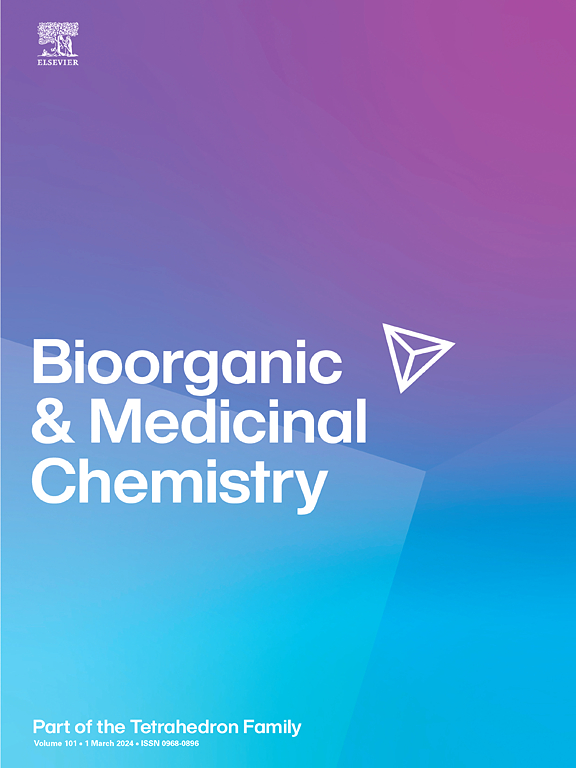Optimizing biofilm inhibitors: Balancing activity and toxicity in 2N-aminated 5-aryl-2-aminoimidazoles
IF 3.3
3区 医学
Q2 BIOCHEMISTRY & MOLECULAR BIOLOGY
引用次数: 0
Abstract
To evaluate the effect of amination on biofilm inhibition against Escherichia coli, Pseudomonas aeruginosa and Staphylococcus aureus, representative compounds of two previously described 5-aryl-2-aminoimidazole (5-Ar-2-AI) classes were aminated by installing an amino group at the end of the substituted n-alkyl chain. Amination led to an improvement in activity for one of the two classes, the 2N-substituted 5-Ar-2-AI class. Based on these findings, a more extensive library of 2N-substituted-aminated 5-Ar-2-AIs was synthesized having different n-alkyl and halogen substitutions on the 2N-position and the 4(5)-phenyl ring, respectively. Compounds were evaluated for their biofilm inhibitory activity against E. coli, P. aeruginosa, S. aureus, Staphylococcus epidermidis and MRSA. Additionally, their toxicity was tested on eight continuous cell lines, peripheral blood mononuclear cells and Caenorhabditis elegans, along with their genotoxicity on Capan-1. Halogenation and elongation of the n-alkyl substituent showed a positive effect on biofilm inhibitory activity, but also increased toxicity. Compromising between activity and toxicity, a non-halogenated 2N-substituted-aminated 5-Ar-2-AI compound with an intermediate n-heptyl substitution demonstrated promising broad-spectrum biofilm inhibition, making it a suitable candidate for further research in anti-infectious medical applications.

优化生物膜抑制剂:平衡2n -氨基化5-芳基-2-氨基咪唑的活性和毒性
为了评估胺化对生物膜抑制大肠杆菌、铜绿假单胞菌和金黄色葡萄球菌的作用,我们通过在取代的正烷基链末端安装一个氨基来胺化两个先前描述的5-芳基-2-氨基咪唑(5-Ar-2-AI)类的代表性化合物。胺化导致两类化合物之一的活性提高,2n取代的5-Ar-2-AI类。基于这些发现,我们合成了一个更广泛的2n取代氨基化5- ar -2- ais文库,它们分别在2n位置和4(5)-苯基环上有不同的n-烷基和卤素取代。化合物对大肠杆菌、铜绿假单胞菌、金黄色葡萄球菌、表皮葡萄球菌和MRSA的生物膜抑制活性进行了评价。此外,在8个连续细胞系、外周血单核细胞和秀丽隐杆线虫上测试了它们的毒性,以及它们在Capan-1上的遗传毒性。正烷基取代基的卤化和延伸对生物膜的抑制活性有积极的影响,但也增加了毒性。一种具有中间正庚基取代的非卤化2n取代氨基化5-Ar-2-AI化合物在活性和毒性之间取得了折衷,显示出有前景的广谱生物膜抑制作用,使其成为抗感染医学应用进一步研究的合适人选。
本文章由计算机程序翻译,如有差异,请以英文原文为准。
求助全文
约1分钟内获得全文
求助全文
来源期刊

Bioorganic & Medicinal Chemistry
医学-生化与分子生物学
CiteScore
6.80
自引率
2.90%
发文量
413
审稿时长
17 days
期刊介绍:
Bioorganic & Medicinal Chemistry provides an international forum for the publication of full original research papers and critical reviews on molecular interactions in key biological targets such as receptors, channels, enzymes, nucleotides, lipids and saccharides.
The aim of the journal is to promote a better understanding at the molecular level of life processes, and living organisms, as well as the interaction of these with chemical agents. A special feature will be that colour illustrations will be reproduced at no charge to the author, provided that the Editor agrees that colour is essential to the information content of the illustration in question.
 求助内容:
求助内容: 应助结果提醒方式:
应助结果提醒方式:


